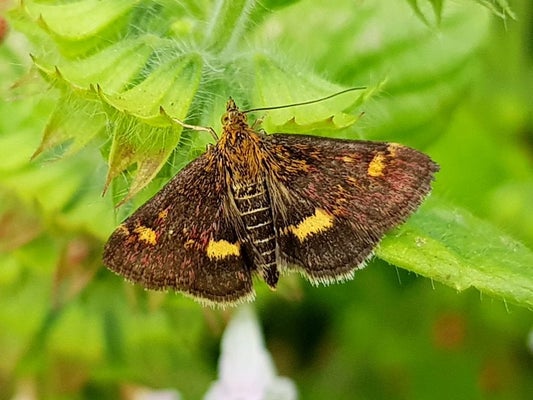
Quick facts
Common name - Mint moth
Scientific name - Pyrausta aurata
Plants affected - mints (Mentha species), marjoram (Origanum vulgare), meadow-clary (Salvia pratensis), lemon balm (Melissa officinalis), catmint (Nepeta cataria) and calamints (Calamintha spp.).
Caused by - caterpillars
Timing - spring and summer
What is mint moth?
The adult moth has a wingspan of up to 2 cm and has reddish brown to bright purple wings with golden markings. It is the larvae of the mint moth that are responsible for causing low levels of damage to a range of herbaceous plants in the mint family, the Lamiaceae. Adults are small, attractive, moths that can be found resting on host plants during sunny summer days.
Symptoms
- Caterpillars of this moth can be found feeding on several common garden plants
- Young growth at the shoot tips is often damaged, leaves may be curled over, small amounts of fine webbing and tiny black pellets of caterpillar excrement will be present
- Caterpillars grow up to 13 mm long before pupating
- Caterpillars vary in colouration, ranging from shades of pale green to a reddish/purplish brown, whatever the background colour there are two paler stripes running longitudinally down the back and regularly spaced groups of small black spots

Management
The presence of the caterpillars of this moth rarely cause significant damage in gardens and it can usually be tolerated, on a healthy plant there are usually unaffected leaves that can be used. Caterpillars and associated moths are important as a food source for other garden wildlife and so should be preserved where possible.
- Where possible tolerate populations of caterpillars, as butterflies and moths are an important part of the garden ecosystem
- Encourage predators and other natural enemies in the garden such as birds, hedgehogs and ground beetles
- Check susceptible plants regularly from late April for the presence of larvae and remove by hand where practical
- Heavily affected shoots can be cut back this will also stimulate new growth
Biology
The mint moth has two generations a year with caterpillars active in spring and summer. Young caterpillars feed on the underside of leaves and later web together plant material including the flowerheads. When fully grown the larvae will be approximately 13 mm long and will pupate within a cocoon in the larval feeding place. There are other species of moth of the same size and colouration which do not cause problems on herbs.

